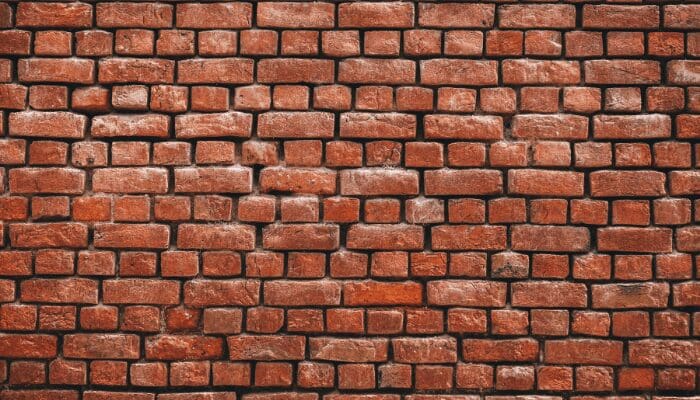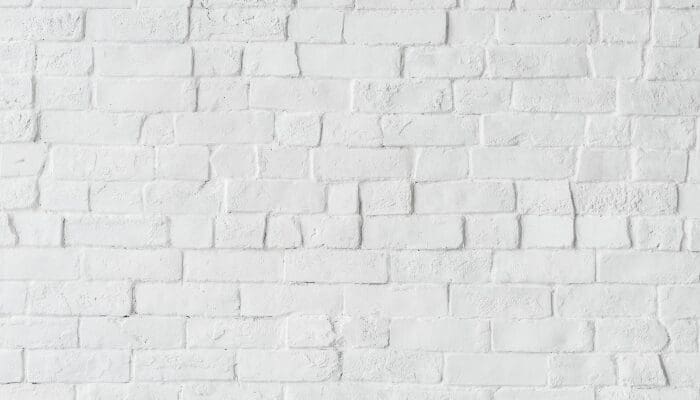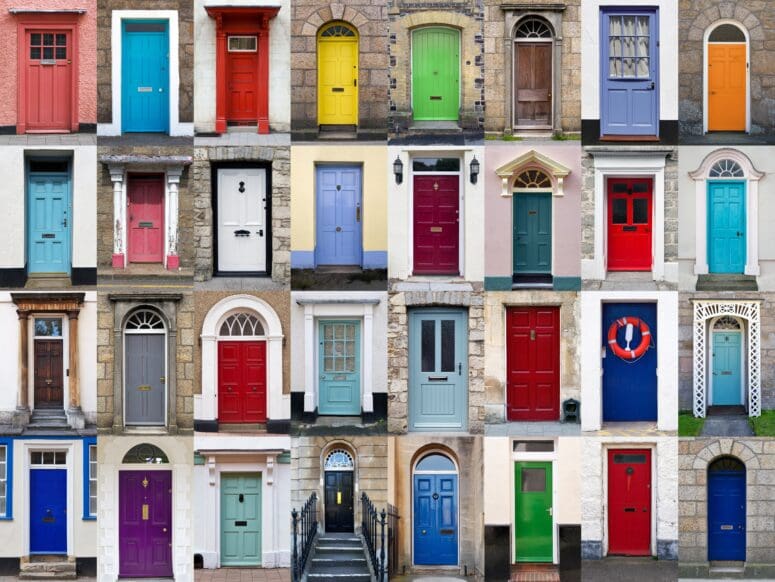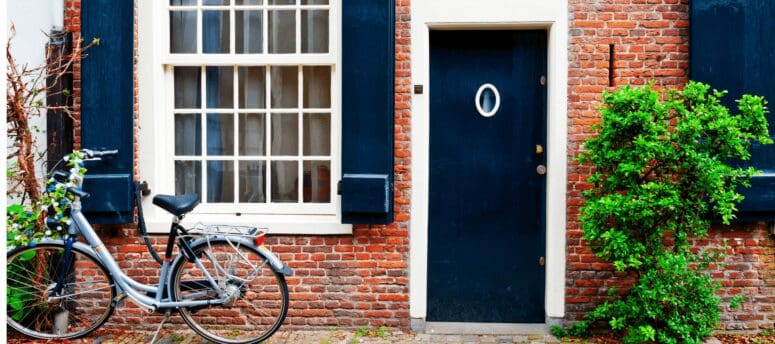3 Ways to Take Your Brick House Curb Appeal to a Whole New Level
- Published on
-
 Christine Bartsch Contributing AuthorClose
Christine Bartsch Contributing AuthorClose Christine Bartsch Contributing Author
Christine Bartsch Contributing AuthorFormer art and design instructor Christine Bartsch holds an MFA in creative writing from Spalding University. Launching her writing career in 2007, Christine has crafted interior design content for companies including USA Today and Houzz.
You don’t need to revisit the tale of “The Three Little Pigs” to know that a brick home has a warm, sturdy charm that appeals to buyers. However, if you’re the proud owner of a brick home (and why wouldn’t you be proud?), these sun-dried clay blocks alone won’t guarantee a successful sale if your curb appeal is lacking.
Grooming your greenery and adding colorful flowers will amp up your brick house curb appeal, but those finishing touches can’t mask outdated architectural elements or damaged brickwork on your home’s exterior.
You might think that nothing can be done to restore or alter a brick home. But you’re not stuck with the builder’s design choices and your repair work doesn’t have to look glaringly obvious if you use the right techniques, backed by professional masons. If you’ve got brick, trust us, you’ll want to flaunt it. Or better yet, take it from real estate pros who know exactly how much buyers swoon over a charming brick house.
1. Repair damaged bricks and loose mortar
As those little pigs discovered, durable bricks offer great protection, keeping your loved ones safer when disasters like house fires or severe weather strike (and not just from the big bad wolf).
The downside is, the same rigid durability that protects you makes bricks susceptible to long-term damage. Its inflexibility means that extreme temperatures and water absorption from rain and snow can lead to crumbling mortar and pockmarked bricks.

Luckily, in the 6,000 years that masons have been laying bricks (the world’s oldest manufactured product), they’ve perfected techniques to replace damaged bricks and repair loose mortar without tearing out the whole wall to do it.
Loose or damaged mortar is easily fixed with a technique called repointing or tuck-pointing. Replacing wind-worn or damaged bricks is also doable, even on historic brick homes.
If you do the right research and use the proper mortar or lime-based putty, repointing and brick replacement is a challenging project that some handy homeowners can tackle without hiring a professional mason.
But it is time consuming and risky. If not done right—which a home inspector is sure to notice—both the bricks themselves and the structural foundation of your home may be damaged.
You need to wait for the right weather, too—because repointing should only be done when the temperature is between 40 to 90 degrees, or the mortar won’t cure properly.
And unless you’re repointing the whole house, color-matching mortar and bricks is also an issue, especially on historic homes with hard-to-match vintage bricks.
Don’t worry if DIY brickwork repair is out of your comfort zone—hiring a professional mason won’t break your budget. The cost to hire a mason averages between $400 to $670 for repointing. And for repairs that require brick replacements, the national average is $1,319.
A professional mason also knows the right bricks and mortar to use and has the experience to stain and color-match your existing brickwork. Masons experienced repairing historic homes will also likely know of salvage companies to find era-appropriate replacement bricks where available.
2. Give your brick a makeover with paint or whitewashing
If the history of your brick home is one of its selling points, then your agent will advise keeping your exterior in its original condition. But if yours is a more modern, cookie-cutter brick home, there’s a lot you can do to improve and enhance its curb appeal.

One fast and inexpensive option is to paint the bricks in a bright, eye-catching color, although this can be a pricey project. The national average to paint a brick home is $7,000, in part because the exterior needs to be primed first.
However, skip the paint if you live in a high-moisture region. Bricks are porous and absorb ground moisture that can’t evaporate if they’re painted. What you can do instead to alleviate dark brickwork is giving it a simple whitewash—a technique that dilutes the paint with 50% water.
If the painted brick look isn’t right for you or your climate, you still have options to change the overall look of your brick home with a resurfacing technique—without losing the brick’s charm.
One option mimics the look of an Old World, European cottage with bricks partially revealed by crumbling plaster. Known as the German smear, this technique softens the hard lines and dark look of brick with a layer of light, bright mortar that leaves some of the brickwork exposed.
3. Boost the charm factor of your entrance
No matter how much you do to improve or change the look of the brick itself, it’ll still look ordinary if you have a boring front door. Luckily, there are several front door fixes that will transform the ordinary into extraordinary curb appeal.
Give your front door a fresh coat of paint
The simplest and least expensive way to achieve that transformation is by painting your front door a bright color. Almost any color works, because the bricks act as neutral background, however your agent may advise choosing an buyer’s eye-catching red or yellow.

If your front door needs more help than painting can offer, replace it. Replacement runs anywhere from $477 to $1,399 depending on how much work is involved. Save time and money by choosing a new door that’s the same dimensions as your old one—because widening a doorway on a brick house is more difficult than on a wood-framed house.

Replace your front door or dress it up with new hardware
A new front door is high on the list of exterior improvements that buyers want and that add the most value. Changing out the front door handle and hinges completes the look, especially if you opt for a era-inspired replica on your historic brick home.
“The doorknob itself is the first thing people interact with,” says Brendan Bartic, a Denver real estate agent who ranks #15 of 14,307 agents. “So you’ll see a lot of homes that have rusted doorknobs or it’s really hard for the key to work. Whatever the situation, those are things that you want to make sure are corrected.”
Build a front porch for a charming first impression
The most dramatic way to transform your bland front door into a grand entrance is by adding a front porch or portico.
A statement entryway draws the eye, inviting potential buyers inside—especially if it’s a feature not found on neighboring homes. And if you build it big enough for seating, you’ll be increasing your outdoor living space, which can raise your asking price.
Unfortunately, this project does come with a sizeable price tag. The national average to add a 16′ x 20′ front patio will run you around $21,670—because they’ll need to pour a concrete slab and attach the roof without damaging the existing structure.
But with smart budgeting, you can build out a smaller portico for as little as $5,000 to $10,000.
If you already have a front porch, make sure it’s in great, workable condition before you list.
“I always tell people–if I see a sagging front porch or something that doesn’t look correct on the front porch it’s immediately going to make me think that there might be a foundation issue even if there’s not…Fix it so that people don’t look into something that maybe isn’t there,” says top 1% Washington real estate agent Jenah Mahan.
You can expect to pay between $1,100-$1,300 for a porch repair.
Brick homes have an enduring beauty that appeals to buyers. Exterior improvements designed to enhance the brick are a surefire way to get the best offer from those buyers.
Article Image Source: (hermitis/ Shutterstock)
